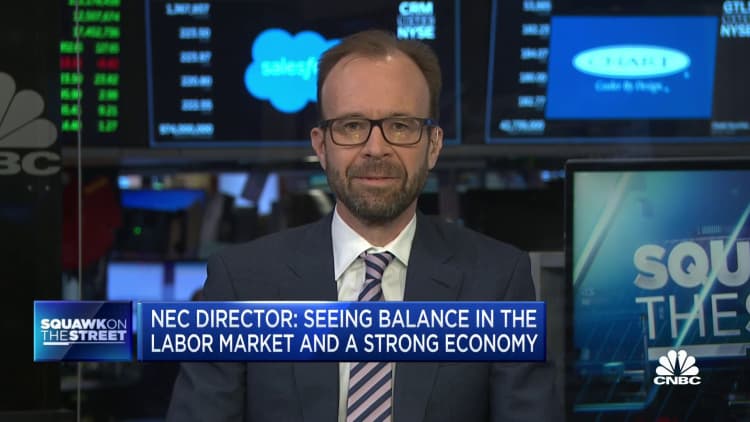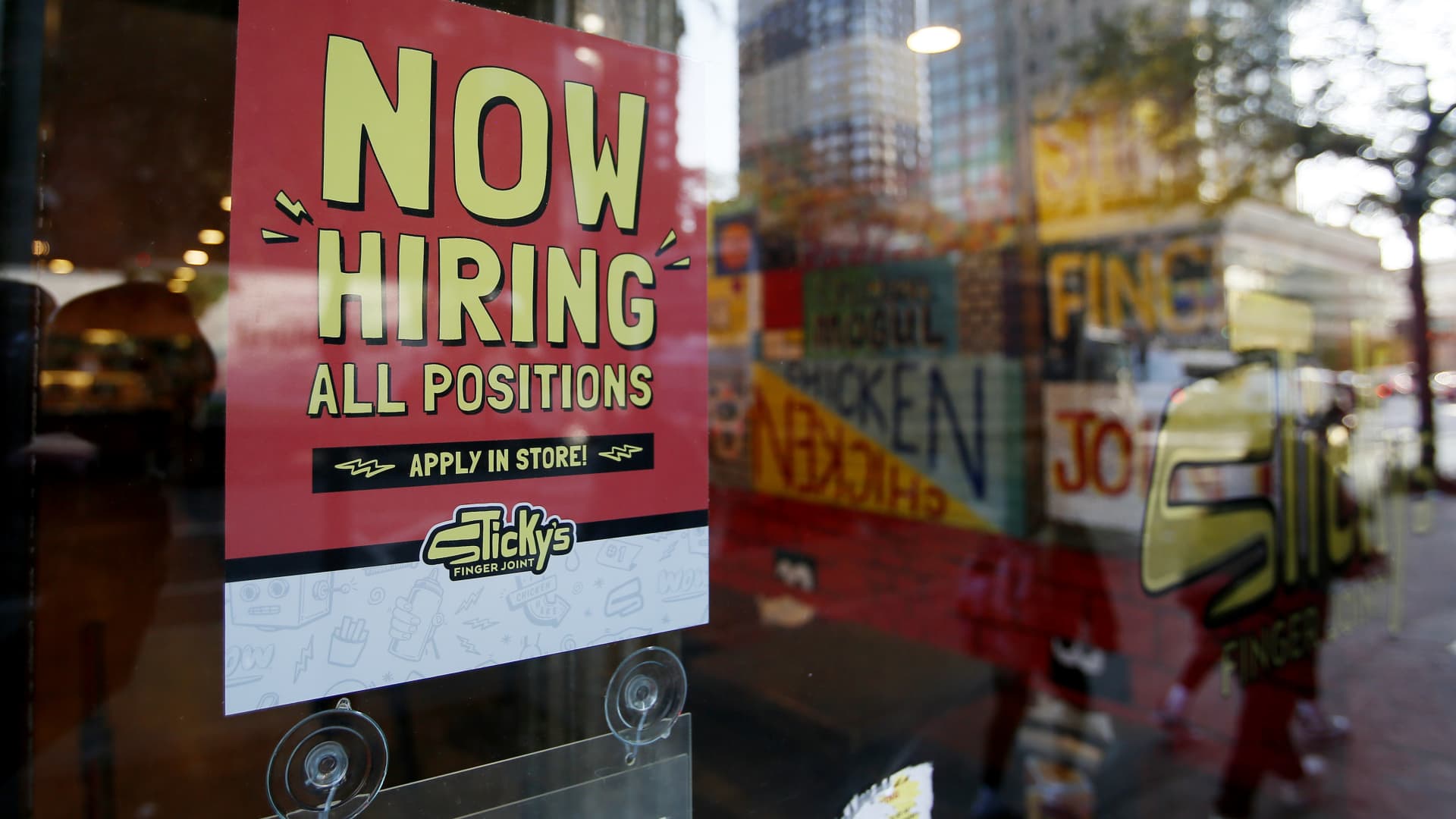The unemployment charge rose sharply in August, because the summer time of 2023 neared an in depth with a job market in slowdown mode.
Nonfarm payrolls grew by a seasonally adjusted 187,000 for the month, above the Dow Jones estimate for 170,000, the U.S. Bureau of Labor Statistics reported Friday.
Nonetheless, the unemployment charge was 3.8%, up considerably from July and the very best since February 2022, and nonfarm payrolls estimates for earlier months confirmed sharp downward revision. That enhance within the jobless degree got here because the labor pressure participation charge rose to 62.8%, the very best since February 2020, simply earlier than the Covid pandemic declaration. The overall labor pressure dimension elevated by 736,000.
A extra encompassing unemployment measure that counts discouraged staff in addition to these working part-time for financial causes jumped to 7.1%, a 0.4 proportion level enhance and the very best since Might 2022.
Common hourly earnings elevated 0.2% for the month and 4.3% from a 12 months in the past. Each have been under respective forecasts of 0.3% and 4.4% and one other attainable signal that inflation pressures are easing. Hours labored nudged larger to 34.4.
“The U.S. labor market continues to come back again to earth however from a really excessive peak,” mentioned Nick Bunker, head of financial analysis on the Certainly Hiring Lab. “The labor market was sprinting final 12 months and now it is getting nearer to a marathon tempo. A slowdown is welcome; it is the one solution to go the space.”
Well being care confirmed the largest achieve by sector, including 71,000. Different leaders have been leisure and hospitality (40,000), social help (26,000), and development (22,000).
Transportation and warehousing misplaced 34,000, doubtless as a result of Yellow trucking chapter, and knowledge declined by 15,000.
Whereas the nonfarm payrolls progress continued to defy expectations, earlier months’ counts have been revised significantly decrease.
The July estimate moved down by 30,000 to 157,000. June was revised decrease by 80,000 to 105,000, making that the smallest month-to-month achieve since December 2020.
“The broad message right here appears to be that we’re nearing full employment, with provide and demand coming extra into steadiness,” Financial institution of America U.S. economist Stephen Juneau mentioned in a consumer notice. “The positive factors are concentrated within the laggard sectors. The remainder of the labor market in all probability is at full employment.”
The surprising enhance within the jobless charge got here because the rolls of the unemployed grew by 514,000. The family rely of these employed elevated by 222,000. A lot of the jobs got here from the non-public sector, with authorities contributing simply 8,000.
The Hollywood writers’ strike and the Yellow trucking chapter mixed in all probability lowered the payrolls rely by 50,000, in keeping with Goldman Sachs.

In relation to the carefully watched jobs rely, August is usually one of the vital risky months of the 12 months and could be topic to sharp revisions later. Whereas the preliminary estimate and remaining counts in 2022 have been little modified, the 2021 determine ended up greater than doubled within the remaining rely.
August’s jobs studying comes at a pivotal time as Federal Reserve officers look to chart a course ahead for financial coverage.
Markets extensively anticipate the Fed to skip a charge enhance at its Sept. 19-20 assembly. Nonetheless, market pricing nonetheless factors to a couple of 38% likelihood of a remaining hike on the Oct. 31-Nov. 1 assembly, in keeping with CME Group knowledge.
“This report is kind of proper in keeping with Fed expectations,” mentioned Dan Greenhaus, chief economist and strategist at Solus Various Asset Administration. “The labor market continues to sluggish and loosen, even accounting for the strike exercise, and I do not suppose a lot about this report adjustments the Fed narrative.”
Goldman Sachs mentioned the payroll numbers assist affirm the agency’s forecast that the Fed is completed climbing charges throughout this cycle. By a sequence of 11 will increase, the central financial institution has taken its key borrowing charge from near-zero to a goal vary of 5.25%-5.5%.
Current knowledge has painted a combined image of the place the economic system is headed, with total progress holding regular as customers proceed to spend, however the labor market starting to loosen from traditionally tight circumstances.
Job openings, for example, fell to eight.83 million in July. That is nonetheless properly above the place they have been earlier than the Covid pandemic however is the bottom degree since March 2021. That equated to 1.5 openings for each employee the BLS counts as unemployed.
On the identical time, inflation has proven indicators of cooling regardless that it stays properly above the extent the place Fed policymakers really feel comfy.
The Commerce Division reported earlier this week that non-public consumption expenditures costs, the Fed’s most popular inflation gauge, rose simply 0.2% in July. That equated to a 3.3% 12-month achieve, or 4.2% when excluding meals and power – the “core” degree that the Fed thinks is a greater measure of longer-term inflation.
Shopper spending was robust in the course of the month, rising 0.6% when adjusted for inflation regardless that actual disposable private revenue fell 0.2%. Households have been utilizing bank cards and financial savings to compensate, as the non-public financial savings charge fell to three.5% in July, down sharply from the 4.3% degree in June.
The division additionally reported that gross home product elevated at a 2.1% annualized charge for the second quarter, a degree that’s nonetheless above what the Fed considers pattern progress for the U.S. economic system however under the preliminary 2.4% estimate.
Nonetheless, the Atlanta Fed is monitoring third-quarter GDP progress at a sturdy 5.6% tempo. That counters long-running expectations that the economic system is more likely to hit no less than a shallow recession following a sequence of aggressive Fed rate of interest hikes.

